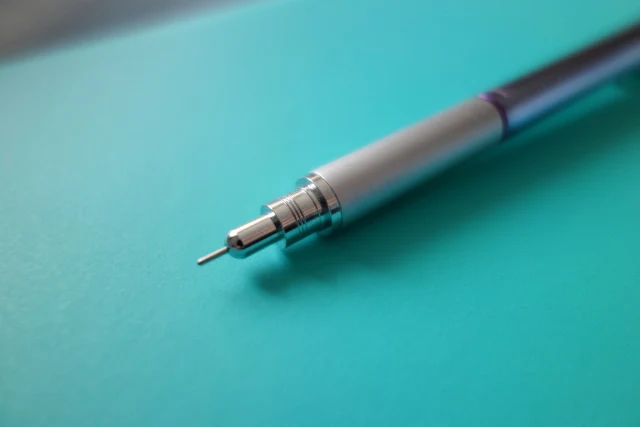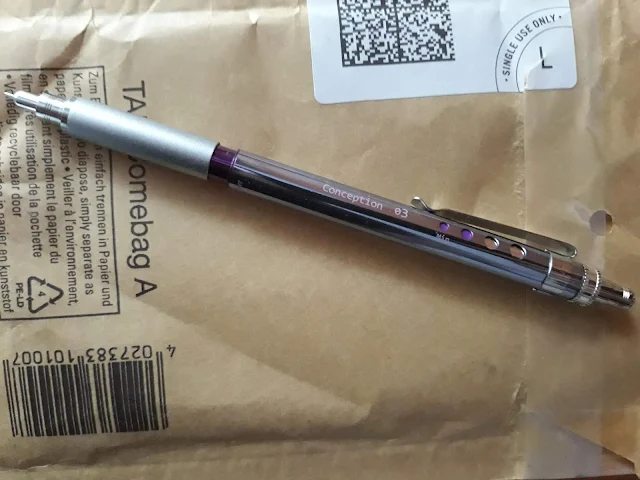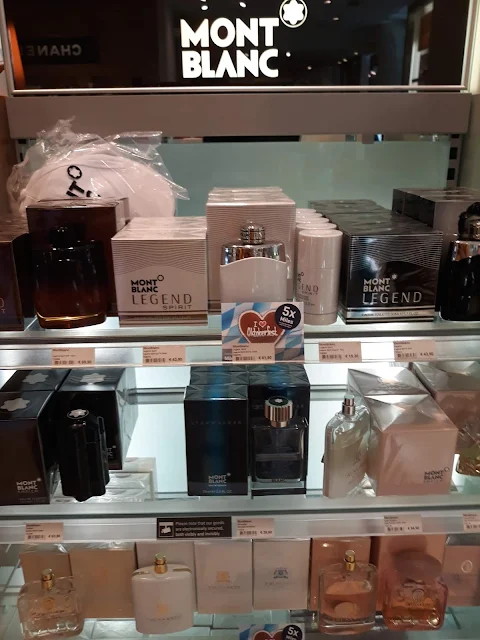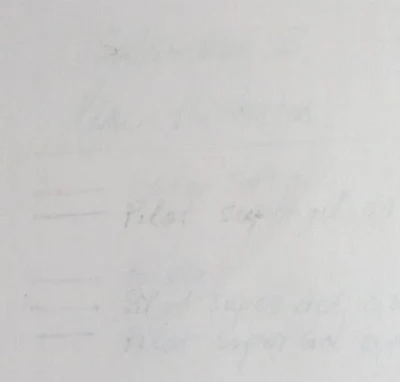Thursday, December 27, 2018
Review of the Ohto Conception mechanical pencil
Excuses aside I want to review the Conception mechanical pencil which I have mentioned about in a previous post. Tanks to Matthias from Bleistift blog, Dave from Dave's mechanical pencils and
Brad from The Pen Addict.
This pencil was reviewed by Mathias from Bleistift.com some time ago, so please check his post and the youtube video.
I have seen them at that time but can’t remember the conclusion so this will be my view on the mechanical pencil. It will be interesting to see after, how each views the same product.
First of all the color, which I find it to be very nice. It could be seen as a bit feminine, but I think it works for everyone. It is an all metal body, with the barrel a light pale purple, a midsection with a darker violet. The grip is a mat finish gray that has a bit of tactile feel to it and it has enough grip. The rest of the pencil: tip, clip, and pusher are glossy gray.
The pencil has very subtle markings, OTO and Conception along with lead size, that is written in a color that is close to the barrel color and in a small font. It gives the pencil a clean look and technical feel.
This pencil has 2 very interesting features that make it a bit unique. The first thing that you notice are 4 holes in the side of the barrel that show you how much the lead advances. Yes, you can control it. So if you ever felt the traditional mechanical pencil doesn’t got this right you can opt for the Conception. At the maximum setting, the lead will advance 15 mm after 10 clicks and the minimum setting will offer 4 mm of lead for 10 clicks. A huge difference, and of course you can set it any ware between this 2 values.
The second unique feature of this mechanical pencil is the fact you can have a fixed sleeve or a retractable sleeve. By screwing the barrel to the grip you make it a fixed sleeve, that is very good for technical work, and precision lines. While for general writing you might prefer to have a sliding sleeve, so you will click the advance mechanism a lot fewer times. This makes the pencil pocket safe because the sleeve slides all the way in.
The clip and the eraser are good and I do not have complaints about them. One thing that is reminiscent of older pencils is a pointy tip imbedded in the eraser for unclogging the pencil. Rotring has dropped this after the first generation of Tikky, so I do know how to feel about it. Is the pencil not reliable enough and the manufacturer knows you will get into trouble? or is it there just to give you comfort and ease of mind in case something goes wrong? Take it the way you want, I am a bit skeptical.
One thing I have not talked about is the lead size. The pencil in my possession is a 0.3 m lead. It is the first one for me.
I don’t know how to feel about it at this moment, as I have not used it enough. Lately, I am incline to use 0.7 mm more often than the 0.5. I think this is because I rarely need the pencil to do detailed work and mostly I use it for notes. Engineer or not computers are used for the real work stuff while paper and pencils are mostly used to put down some thoughts, ideas and notes.
The fine point is a very different experience even compared to the 0.5 mm, and it offers a lot of control and precision. In the end this lead size to me seams to be a more specialized thing, making it less practical. I mean it is very good for detailed work and taking small notes in a limited space, for example, a book, but will not be very good for writing as you will frequently need to click the advance mechanism. Having a fine point makes it more fragile and having a sliding sleeve will make your lead break fewer times or not at all.
So in my opinion the purpose of the sliding sleeve in this pencil is more for protection, and not for long writing sessions.
The pencil offers a very nice feel in hand, for me is a great fit. One thing that I would change is the transition from the barrel to the grip section. It should have been better grinded to make a smoother transition.
One other thing I would like to mention is the screwing mechanism that makes the sleeve fixed or slide and the click of the lead advance. You can feel the spring that offers resistance and it is not smooth or quiet. It is not too bad, but I feel there is room for improvement.
Thursday, December 6, 2018
10 $ or less
Here are a few ideas
For the South Park fans, here are some Cartman quotes on the side of pencils
You can buy them here
If you enjoy the good attitude and hard-working spirit of Sponge Bob you can go for the eraser set, that includes figurines of Mr. Krabs and Patrick as well.
Eraser set
And where better to put the pencils and erasers you just purchased, if not in a gross fish like pencil case. I guess you could keep it between real fish for a few days just to offer the realistic feel, smell wise. It also looks really spacy
Fish pencil case
Saturday, November 24, 2018
What lead size to use for general writing

I will start with, science is hard, or at least my pseudoscience is. I will test how the most common lead size perform:
0.5 / 0.7 / 0.9 or 1.0
0.9 and 1.0 is the same size, but different producers refer to it differently. From now on, I will refer to both sizes as 1.0
I guess you already have the answer to my question. Which ever lead size you like the most is the best, and I probably say 0.7 is the most usual lead of them all. But I am going further with my quest. So prepare ...
The so-called test
I wanted to see how much lead is used for the same amount of writing using each of the lead sizes mentioned above.
This is hard work, and I do not think I will be doing science anytime soon after all this experimenting.
I used Rotring HB leads with the aforementioned sizes 0.5; 0.7; 1.0. Other brands might offer different results because of the lead hardness "... 2B B HB H 2H ..." is not standardized. So HB from other suppliers might be softer or harder.
I started the test by writing 1-page size A4 (254x297 mm). To be as consistent as humanly possible, I used "math" paper and wrote in every single cell of the paper with very little pressure, and the same letter height, the letters of the alphabet over and over again. I preferred this method instead of freehand, so the results will be as scientific as correct as they can get.
This is not representative of real world writing, but it doesn't have to be. The important part of the test is comparing the leads to each other and see what are the differences.
After I wrote a few pages with each of the leads that are participating in the writing test, I measured the length of the remaining lead.
The results
In theory, I could have written with a single lead, size 0.5 mm, - 30 pages, but I have to take into account that when the lead becomes too small you have to throw it away, so more realistic I would say 27 pages.
Of course, this depends a lot on how small or big do you write, how condensed, how much pressure etc. So don't focus on this figure, as it is not the important one. The difference between the test results says the story.
The 0.7 mm can write in theory 60 pages and the 1.0 mm over 120 pages. This means that the writing you are able to do with 1 lead doubles every time you bump up the lead size.
Because I could not measure the lead used up on a single page with size 1.0 (under half of mm) I cranked up the pace and applied extra pressure and made a bunch of lines and X.
So after the endurance test the 0.5 mm lost 3.5 mm; the 0.7 mm lost 1.5 mm, and the 1.0 lost 0.5 mm from its total length
It does not seem a lot but assuming I could use the entire lead, 60 mm, the 1.0 size I could do as much writing as with 3 pieces of 0.7 mm lead or 7 pieces of 0.5 lead.
Similarly, if you would take the 0.7 mm as a benchmark, then I would need 2.33 pieces of 0.5 mm lead to do the same amount of writing.
Conclusion
You should choose the thicker lead, especially if you have a heavier hand, for three reasons.
1) The first reason is the price. The price of lead is usually the same for all thicknesses.
You will pay 3 times more if you use 0.7 lead instead of 1.0
You will pay 7 times more if you use 0.5 lead instead of 1.0
You will pay 2.33 times more if you use 0.5 lead instead of 0.7
2) The second reason is the advancing of the lead. The less lead you use, fewer clicks you will have to make. So in a long writing session, a thicker lead is bliss.
3) And third, the risk of breaking the lead is smaller with thicker lead.
Ok, you may ask, "Won't the line be too thick if I use 1.0 mm?"
It will, but not by a lot. There is a small difference between the 0.7 mm and the 1.0 mm lead. The downside is that you have to rotate the pen in your hand more often when you use 1.0 mm lead.
 |
| 1.0 mm vs 0.5 mm lead |
 |
| 1.0 mm vs 0.7 mm lead |
Thursday, October 11, 2018
A Rolex and a Montegrappa
Maybe Rolex Rainbow is not the most conspicuous watch to wear, but I think it will go really well with the Montegrappa Rainbow. Assorting your watch with the fountain pen could be a new trend.
Follow the link to see the post with the first watch - fountain pen combo, a match made in heaven between Kaweco sport and Nomos.
Wednesday, October 3, 2018
Pencils in hotel rooms, Stabilo Schwan 306
I found the markings on it curious, as I know the US marks the lead harness by numbers and HB is the #2 pencil. Well, this is a 2 1/2 pencil so a bit harder than a regular HB.
The finish of the pencil was made for this hotel room, it looks like woody and unfinished. Like a raw pencil. The same feeling the room left me, an old cabin in the woods, except it wasn't in the woods.
I do not know if it was a calculated decision to leave this particular pencil in the room or it was just a coincidence.
So, on the natural finish of the pencil, the brand name, and model number are written in a very dark paint.
The lines put down by the pencil look dark enough and smooth, so no complaints about the writing or the handling of the pencil.
I had to take the paper back to the lab (back home) to test the ease with which the lines are erased from the paper. And it is no problem, it erases well.
Also, there is no sharpening test, as I did not have my Opinel #8 with me.
All in all, it is an ok pencil, that has an interesting finish that goes well with the looks of a cabin in the woods.
Thursday, September 20, 2018
Preview OHTO Conception Mechanical Pencil
A few days ago I received in the mail a small but very impressive package.
Thanks to: Stationery Wiki, and the people who made it possible
Matthias from Bleistift blog the mechanical pencil sponsor
Dave from Dave's mechanical pencils judge
Brad from The Pen Addict judge
How I got the mechanical pencil?
I ended up with this beautiful mechanical pencil as a prize in a competition hosted by Stationery Wiki. I participated with a post on the wiki about the Rotring 500. Irony or not I could choose between a Rotring 500 and the OHTO Conception. I chose the OHTO Conception because I am not familiar with the brand and their products
I also got a cup
What is Stationery Wiki?
A place where to find information and facts about stationery related products and these great people are the
Why this wiki and not Wikipedia?
Because Wikipedia has a filter and if it considers that the page is not of great importance for the public it will delete it to save precious space. At the same time, it can be tricky to find information about pencils, fountain pens, and other similar products and companies.
I wrote a few posts in which I tried to start from the beginning and go to the present days (short timelines): Rotring Tikky, Rotring 500 (the runner up post), Koh-I-Noor Versatil. And every time it was a difficult task.
The Rotring Tikky post was planned more than half of year before i started to write it. Partially because it was hard getting all the info, partly because I wanted to find more info and confirm what I have found, and largely because many times I am pretty busy and when I am not I am lazy :)
Joking aside the project is a great cause and I am a supporter of it.
I did not had the time to enjoy the pencil yet as I was on the road most of last and this week. I will make time for writing a review of the OHTO Conception in 0.3 mm shortly.
Until then you can read the review of the OHTO Conception on Bleistift. Some time has passed since I read this post and can't remember the conclusion or the positives and negatives. So it will be interesting to see how I rate it compared to Matthias.
Thursday, September 13, 2018
Hamburg, Germany and Montblanc in a duty free shop
I just came back from Hamburg, Germany, after a very short trip. And I learned 2 new things.
First, I have to look for flights with more time between them or I should get in a better shape. It was a short and intense trip, as for my flight to Hamburg I had to change planes in Munich, and because the first one had a delay of over an hour I had to run for about 15 gates to get to my second flight just to realize that the gate number had changed and had to run back another 28 gates. I was completely out of breath. I can't even believe that a few years back I ran a full marathon.
The second thing I learned is that Montblanc is also a perfume maker ?!? What ?!?
Maybe Paco Rabanne will start making inks... Not trying to be mean but I do not like this kind of style of business even though this seems to be the future for all brands.
Have someone produce whatever you want to sell, and you use the brand name to make people pay as much as possible for a generic product.
I just hope this is not like Armani watches (replace Armani with whatever clothing brand you would like), pricey pieces of quartz that you should pay around 30 $.
I can't say much about Hamburg as I did not get the chance to visit anything. But I saw a lot of construction sites, brick buildings, and graffiti. Oh, let's not forget about the bubble machine on a car.
Saturday, September 8, 2018
Back to school small notebook
This is the last weekend before schools start again. So this means 2 things. A lot of stationary stuff everywhere and the last 2 days with "normal" traffic.
Yesterday I was in a shop and just noticed this bright neon small notebooks for just 0.25 Euro. I just had to have one of each color as they look very fun.
I enjoy using small notebooks as they are easy to fit in a pocket, in a bag without making it heavy or bulky. And this small size is just enough to write down some quick notes or have as a few backup information that is easy to reach on the go. Or just use it for something as basic as a shopping list.
Sunday, September 2, 2018
Ink Review Koh-I-Noor blue
The fountain pen ink is produced by Koh-I-Noor in the Czech Republic.
It comes in a plastic bottle, 50 g (or roughly 50 ml) like in the picture. The ink doesn't come in any kind of additional packaging, it has no additional box. All this I imagine is to reduce the cost and offer the best possible price to the consumer.
It comes in just 3 colors, blue, black and red (edit: I also found green recently), so a rather limited selection, but the ink is marketed towards students who need a no fuss, inexpensive ink.
And when it comes to price, it is a fantastic one. It is available in about every shop and costs between 1.1 - 1.4 Euro (average of 1.5 USD).
Another cheap contender would be Hero, but the price for a bottle of 60 ml is about 4.8 - 5 USD
Another comparison could be done with Pelikan 4001 blue 1000 ml (which is cheaper than black). The price on Amazon.de for 1000 ml is 26.59 euro, which translates into 0.03 euro/ml or 1.5 euro for 50 ml.
This makes the Koh-I-Noor ink to be more cost-effective even compared to Hero ink. Yes, the Hero comes in a glass bottle and has a box.
Koh-i-Noor is a well-known brand of artists' supplies, and their ink is considered to be of high quality. Their ink is often used by calligraphers, illustrators and artists due to its rich, vibrant color and smooth flow. Some of their inks are also waterproof, lightfast and pH neutral which is great for artists who want to create long lasting works. Many artists and calligraphers also appreciate the fact that Koh-i-Noor inks are made with natural pigments, which can give their work a unique and organic feel. In addition, Koh-i-Noor ink is also used for technical drawings and is suitable for use with fountain pens and dip pens.
So the ink comes in an unimpressive plastic bottle, the label is in Czech and English and this is about it. The top colored band from the label represents the color of the ink.
It is a light blue, not too saturated, but I like the look. The color and saturation is in between the Faber Castell Royal Blue and the Pelikan 4001 Royal Blue. The Pelikan 4001 has a little more of an indigo color in it.
If you are interested in Koh-I-Noor's offer for document ink, you can check the following link:
Koh-I-Noor document blue ink in glass bottle
Friday, August 17, 2018
"Get Out" presents Bic Matic
The movie Get Out presents for a short period of time the famous Bic Matic
It's not the best movie, and I don't know if it deserves the mark it has on IMDB, but it has an interesting scenario.
In the movie, Rod is looking for his 26 year old friend, Chris. And to put down all his ideas, he uses a clear body Bic Matic with a yellow clip.
Also spotted in movies.
Thor using Bic four colours
Bic Matic Grip in cinema
Bic does not seem to be camera shy.
Thursday, August 2, 2018
Rotring 500 review
The 500 is the cheaper version of the 600, but it is not the cheapest in the line. Tthat spot is reserved for the 300 complete plastic build. The 500 is made in Japan and the build seems solid. The grip, lead hardness indicator, and the cap are made out of brass. The clip is made out of stainless steel and the barrel is plastic (ABS) but feels very nice to the touch.
Compared to the original 500 series, the modern version comes only in all black with the text and rings in red. The mechanical pencil has a dead serious look to it, it could be part of any minimalist EDC (if you carry it in a case as the tip is not retractable) or it can sit on an office desk. But the sleek look of the pen over the time will change, as the black color is painted rather than anodized. After heavy use, especially the grip section will show the white metal underneath.
Wednesday, July 18, 2018
Black ink: Faber Castell vs Pelikan 4001
Saturday, July 7, 2018
OEM Kaweco
Sunday, June 24, 2018
Advertising with a pencil
Saturday, June 16, 2018
Continental Typewriter at a flea market

 I took home a #22 spanner, a punch, and a tailor's ruler. Maybe next time I will find some old fountain pens or something related to writing that is worth checking out.
I took home a #22 spanner, a punch, and a tailor's ruler. Maybe next time I will find some old fountain pens or something related to writing that is worth checking out.
Tuesday, June 5, 2018
Ink over time
The test is not very scientific as i used different fountain pens and the exposure to light was different as i did not used all the inks in the test from the begining but still the results are interesting.
Inks used: platinum blue black, Faber Castell royal blue, Faber Castell permanent black, Pelikan 4001 royal blue, Pelikan 4001 black, Pelikan 4001 personal mix 1:1 royal blue and black, Koh I Noor Blue
The test was conducted for a period of 4 months from March until June.
Results:
Koh I Noor blue with the least time exposed to sunlight is almost invisible
Faber Castell royal blue is very hard to read even though it received a similar amount of sun with Pelikan 4001 royal blue
The blacks from Pelikan and Faber Castell look similar after sun exposure.
The winner of the test I would say is the Platinum blue black
The ink was not the only one affected by the sun the paper that was exposed obtain a yellowish tint
Also see: Platinum Preppy
Tuesday, May 22, 2018
Gel Pens Pelikan, Pilot vs cheap brand
I am bringing in to the ring an incredible threesome of gel pens.
Pelikan Soft Gel, Pilot Super Gel and no name brand Forster.
Cold start test.
After a long period of sitting on the shelf. It is the first test because I had to get them started.Pelikan, Pilot Super Gel 0.5 had no problem starting right away. Pilot 0.7 had some issues and Forster needed convincing.
Line width and saturation.
I am testing only general purpose writing colors (blue, black)Black color, test between Pilot 0.7 and Pelikan. I can say that Pelikan produces a hair skinnier line (the size is not advertised) and it seems to be a little less saturated compared to Pilot 0.7 mm
Blue color, test between Pilot 0.5 & 0.7 and Forster. Forster does not specify the width but is around 0.5. It is a lighter blue compared to Pilor but nice color. The width is very close to Pilot 0.5. The 0.7 mm Pilot has a darker color and a thicker line.
Bleeding
I tested all this on cheap copy machine paper, because it is most likely to use this pens in an office environment where this kind of paper is the norm.No surprise the thinner the point less bleedthrough.
Worst performance order:
Pilot Super Gel 0.7 black. Bleedthrough but can be used
Pilot Super Gel 0.7 blue. Bleedthrough but can be used
Pilot Super Gel 0.5 blue. It has decent performance and can be used
On the same place Pelikan Soft Gel and Forster with very little bleedthrough.
Comfort and ergonomics
The best in class is the Pilot, which has a grip section with smooth circles spaced closely. It is comfortable and you can use the pen for long hoursSecond is the Pelikan with a rubber insert. It is at the same level with the plastic body. It feels good but I do not think offers to many benefits.
Last is the Forster which has the grip identical with the rest of the barrel just a bit thicker. It is not uncomfortable to use but for sure they cut some corners to be able to produce them for cheap. It has a sharper edge if you're gripping the pen close to the lead.
Writing experience
The writing is the most important aspect of the pen after all. I can say that all right ok, but my opinion is that Pelikan is the smoothest. Pilot has a bad feel to it, it's like the ball is wobbling inside, it does not seem a quality assembly. And this aspect is true to all of the tested Pilots. Even the Forster felt better to me.Quality
Forster is cheaply made, the cap is not as secure as the other. Also, the clip cannot be used as if you pull it slides out of the cap. This is not valid for all the ones I have only for the blue color. But it shows that the quality control and the design are not the best.Value
This is a very interesting section. Because I don't think it is a surprise to anybody that the quality on a cheap no-name brand is lower compared to Pilot or even Pelikan.But the real question is a cheap product a good value to the customer. Well, it can be a very good value sometimes.
In this case, I think you get 90% of the quality for a lot less money
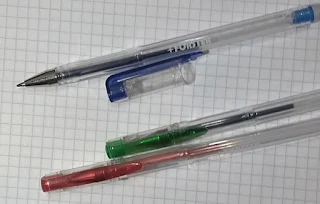 It's not the most scientific test you can make but sometimes you need to simplify the process and admit that your mileage might vary.
It's not the most scientific test you can make but sometimes you need to simplify the process and admit that your mileage might vary.How long will the pen write depends on the level of ink inside. Of course, other factors influence the mileage, like the line thickness, reservoir diameter, and ink viscosity. So the 0.5 pens will last longer than 0.7.
But to compare the pens (0.5) without writing until the pen is out of ink I measured the ink inside. I assumed the diameter and viscosity of the gel holder are similar so I did not take this into consideration while doing the measurements. Pelikan and Forster do not say the line thickness but I consider them to be a 0.5 as they are very close to the Pilot in width.
| Brand | Ink level | Price | Ink | Price |
| cm | eur | comparison | comparison | |
| Froster | 9.7 | 0.24 | benchmark | benchmark |
| Pelikan Soft Gel | 10.7 | 0.64 | + 10.3% | 267% |
| Pilot Super Gel | 9.9 | 0.99 | + 2% | 413% |

In this situation, Forster is cheaper by a mile. It holds less ink but it is cheaper between 2 and 4 times than Pelikan and Pilot. That in my book is called a good deal. But there is a catch. The ink levels between my Forster pens vary a bit. One of them has 1.5 cm less than the one I measured. Another one is 0.9 cm less. So this is not very consistent. But even if I would redo the test, and I would use the one with the smallest amount of ink the test will still look great. The Pelikan would hold ~ + 30% more ink but still costs 2.67 times more. The Pilot would hold around + 20% more ink and would still cost more than 4 times as much. So you can buy for each 2 Pelikans 5 Forsters, And for each Pilot 4 Forsters.
Friday, May 11, 2018
Review Faber Castell Grip 1345 mechanical pencil
 |
| Faber Castell 1345 Grip II, 0.5 mm in blue |
There are 14 available barrel colors to pick from. The Faber Castell green, a traditional burgundy, dark blue, black and other very nice pastel colors.
I have, and will review the Faber Castell Grip II model, 1345 (that is 0.5 mm) color blue.
Because the pencil is made out of plastic, it is a light mechanical pencil, but it does feel good and solid in the hand.
Faber Castell has put thought into the pencils design. The barrel is made out of a glossy plastic. On the barrel, it is embossed with gold like paint GRIP 1345 0.5 the Faber-Castell logo and name.
After more wear and tear, I will say how the writing is holding up.
The top part of the barrel is brushed, so it has a matte finish to it. This makes the pencil more interesting and shows that someone has put thought about the design of the pencil.
The clip is metallic, elegant and feels secure.
The clicking mechanism holds a very long twist eraser. The plastic seems soft to the touch and has a chromed trim near the eraser. The advantage of this system is the long eraser, and the fact you twist to reveal it, so you do not risk losing the cap. The eraser has 3 cm of usable length, so it will last. Even this is a cool feature to have, and the implementation is nice I will not give it extra points, as I am one of those guys who don't like using the erasers on the mechanical pencils. Not because they are rubbish, but because I do not like the worn look, it makes the pen less appealing.
This way I enjoy a "brand new" pencil everyday.
The downside because of this long eraser is the feeling system. Because this eraser section is so long, it is harder to put the leads in.
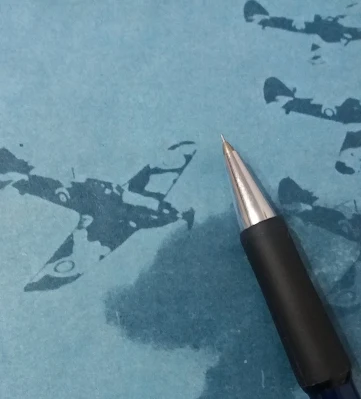 The tip of the mechanical pencil is conical and made from a chromed metal. It offers a retracting and sliding sleeve, so it makes for a pocket safe mechanical pencil. The retracting and sliding sleeve does not have a wobble to it, when you write it feels just a regular non-retractable sleeve.
The tip of the mechanical pencil is conical and made from a chromed metal. It offers a retracting and sliding sleeve, so it makes for a pocket safe mechanical pencil. The retracting and sliding sleeve does not have a wobble to it, when you write it feels just a regular non-retractable sleeve.Because of the conical tip, it's not a drafting pencil, it is intended for general use. The pencil comes with spring lead protection, meaning if you press harder on the lead, the lead will be cushioned by a spring. This works if you have a more vertical way of holding the pencil.
I like the way the sliding sleeve works (this is a feature also named "automatic" on some mechanical pencils). When the lead is used and the sleeve will hit the paper, and so it will slide back a little bit, revealing the lead. This means you can use the advance system less and the lead will be far less susceptible to break. But not all "automatic" pencils are created equal. Some of the problems this system encounters are: too much pressure to slide the sleeve, sleeves that do not have the right angle and not enough polish making them scratchy. I would give the Faber Castell Grip an 8.5/10 score for this feature. It works almost perfect.
The advance mechanism makes a nice clicky sound when pressed. The lead advancement is on the low side. 5 clicks will offer 3 mm of lead. In comparison, the Rotring Tikky (version 3) puts out 4.5 mm.
The grip section is made out of soft rubber. It is very comfortable and nicely integrated into the barrel, but I suspect it will have a relatively short life. It seems a bit soft, and it moves a bit under pressure, I think with time it will become looser. This is the drawback of the rubber grips. They are comfortable but not durable, and can be annoying to feel it move in hand. Other problems that might appear over time with rubber grips are: the hardening of the grip to the point it is uncomfortable, it cracks, or the rubber becomes sticky.
All this makes the Faber Castell Grip 1345 a very nice mechanical pencil, that I am happy to use as my daily writer.
Popular Posts
-
This is the best and most fun game you can play, and you have to try it now. Why? Because it's hilarious, fast-paced, everyone in the...
-
I am a long Rotring Tikky user and today I will share with you the beloved mechanical pencil. I got my first Rotring mechanical penci...
-
Jinhao made me very curious with one of its latest fountain pen in the lineup. I had to have the pen just because of its nib. It is a bit un...
-
Rotring has moved away from fountain pens over the years. The only fountain pen model that is still available is the Rotring Artpen, whic...
-
Wing Sung 612 fountain pen Today I will share with you my very old Wing Sung 612 fountain pen, which is a Chinese Parker 51 look...


